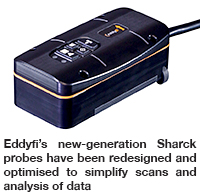Eddyfi launches new generation of probes
17/07/2017
As a world leader in electromagnetic inspection technologies, Eddyfi has announced a new generation of field-proven Sharck™ probes, which are dedicated to carbon steel crack assessment. The tangential eddy current array (TECA™) probes have been redesigned to incorporate user-requested features and improvements inspired by lessons learned in the field. For example, the probe’s active surface is now more resistant to wear and tear (by up to 10 times), new control buttons on the housing facilitate one-man inspection and the ergonomics are improved.
The tangential eddy current array (TECA™) probes have been redesigned to incorporate user-requested features and improvements inspired by lessons learned in the field. For example, the probe’s active surface is now more resistant to wear and tear (by up to 10 times), new control buttons on the housing facilitate one-man inspection and the ergonomics are improved.Beyond these design improvements, all Sharck probe set-ups have been optimised to simplify data visualisation during scans and analysis. Dedicated software tools also make it easier and faster to analyse data:
- Fewer views and C-scans are necessary to fully assess and sentence a weld quickly
- Sizing overlays and cursors automatically provide the length and depth of detected cracks
- Data analysts are prompted to confirm or adjust the automated measurements from the system when a defect is discovered
- The result is a compelling data display for quick and intuitive analysis.
"The patent-pending Sharck probes are designed around the user’s needs," said Angélique Raude, Surface Inspection Product Manager at Eddyfi. "They replace conventional inspection methods such as penetrant testing (PT) and magnetic particle testing (MT) in a wide range of applications. Through paint and coatings and with minimal surface preparation, they are the fastest, simplest and most reliable probes to detect, size and assess the depth of cracks in vessels, tanks, bridges and other assets."
The Sharck probe family comprises the following probe models: butt weld; fillet weld; straight pencil; and right-angle pencil.
Eddyfi has also recently introduced a version of its Sharck probe that is specifically intended for the in-ditch direct assessment of stress corrosion cracking (SCC) in pipelines.
SCC is the result of stress and a corrosive environment on metal and is therefore common on the external surface of carbon steel pipelines in contact with corrosive soil. Because of the nature of SCC colonies (surface-breaking cracks in the form of shallow, extremely fine branches) found on pipelines, they are challenging to detect and size (especially the depth) with traditional non-destructive testing (NDT) techniques.
Current inspection techniques used in assessing SCC have several limitations addressed by the high-resolution Sharck probe. Detecting SCC is usually performed with MT or dye penetrant inspection (DPI), which is time consuming, hard to deploy in some weather conditions and requires extensive surface preparation. Once detected, ultrasonic testing (UT) is used to determine the depth of individual cracks within an SCC cluster, a highly challenging and operator-dependent task, especially where multifaceted, shallow cracks in various orientations are involved.

The high-resolution Sharck probe was designed to detect cracks as shallow as 0.25 mm and as short as 2 mm, as well as to accurately size cracks as deep as 3 mm. Furthermore, the probe has a flexible inspection interface offering a wide coverage of 71 mm compatible with pipes that are 254-1220 mm in diameter. Finally, to take into account the most common coatings and paints applied to pipeline surfaces, the new Sharck probe can tolerate coating thicknesses up to 2 mm, removing the need for pre- and post-inspection surface preparation.
Capable of scanning at speeds of up to 600 mm/s, the probe has a robust design. Its built-in encoder enables accurate positioning of defects and measurement of their length directly from scan results, through the use of 2D and 3D C-scans. Depth values are automatically extracted for rapid assessment.
"We are very proud of this latest addition to the Sharck family. The high-resolution Sharck probe was designed to offer a better solution to the stress corrosion cracking direct assessment (SCCDA) market. Its design and real-time digital mapping enable users to detect and size defects with assurance and repeatability. The solution is meant to offer an alternative to the traditional combination of two methods for SCC detection and depth measurement. Finally, the probe fully complies with the NACE SP0204 standard practice," said Angélique.
www.eddyfi.com